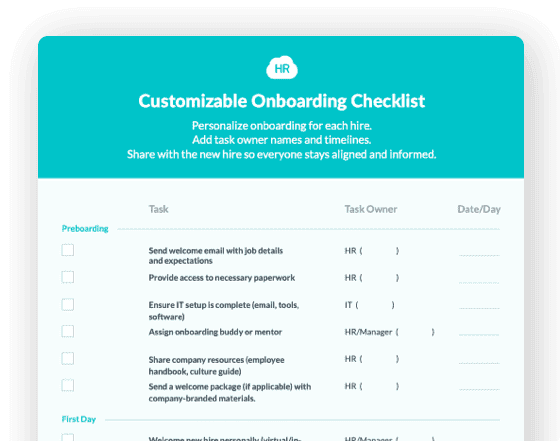Post-Tax Salary
- Net Pay: Defining the Take-Home Post-Tax Salary
- Key Points for Management
- Post-Tax vs. Pre-Tax Deductions: A Value Comparison
- Best Practices for Managing Post-Tax Salary
- Pitfalls to Avoid in Post-Tax Salary Management
- Industry Applications of Post-Tax Salary
- Implementation Plan: Applying the Post-Tax Salary Concept
- Future Outlook and Trends

 Cut onboarding time
by 60%—here's the
Ultimate Checklist
that helped do it.
Cut onboarding time
by 60%—here's the
Ultimate Checklist
that helped do it.

Post-tax salary is the money an employee gets after all deductions. People also call it net pay or take-home pay. It is the final amount. Business leaders must understand and share this number. It affects how happy employees are, how you forecast cash flow, and your overall payroll compliance.
This net amount is what truly matters when team members plan their personal budgets. An employment offer shows the high-level gross annual salary. But the post-tax salary is the real, spendable money. It drives an employee's daily financial reality. Managing what makes up the final post-tax salary is a core job for human resources and finance departments. When the final paycheck is clear, it builds trust. It also causes less confusion about pay.
The calculation is complex. It is not just one simple subtraction. It includes federal, state, and local income tax. It also includes mandatory Federal Insurance Contributions Act, or FICA, taxes for Social Security and Medicare. Plus, there are voluntary pre-tax and post-tax deductions. You need a robust payroll system and clear internal talks to manage all these variables. Using a modern human capital management system helps greatly.
Net Pay: Defining the Take-Home Post-Tax Salary
Post-tax salary is the end result of the payroll process. It is the actual money deposited into an employee’s bank account. This figure is calculated after all required taxes and final deductions are taken out.
It is vital to understand the parts that create this final number. This keeps employee pay transparent and accurate.
Gross Pay:
This is the starting amount. It is the total pay before any deductions. It includes base salary, wages, bonuses, commissions, or overtime pay. This is the figure usually shown in job offers.
Mandatory Taxes:
These include federal, state, and local income tax withholdings. They also cover FICA taxes for Social Security and Medicare. These amounts are deducted based on the employee's Form W-4 and current tax laws.
Pre-Tax Deductions:
These amounts are taken out before taxes are figured. They lower the employee's taxable income. This gives an immediate tax benefit. Examples are traditional 401(k) contributions and health insurance premiums.
Post-Tax Deductions:
These amounts are taken out after all taxes are figured and withheld. They do not lower taxable income. The employee already paid taxes on this money.
For an employee, a higher post-tax salary means more money they can spend. This is key for their financial well-being. For a company, correct calculation of the post-tax salary prevents errors. Errors can lead to penalties or a loss of employee trust.
Key Points for Management
Accurate payroll processing is more than just an office task. It is a strategic function. It affects financial stability and employee relationships. Business leaders should focus on a few key ideas about post-tax salary. This ensures you maintain the best practices.
Compliance Risk is High:
Errors in tax withholding can lead to significant penalties from the government. This is especially true for mandatory FICA and federal income tax. The employer is completely responsible for withholding and sending the correct amounts.
Taxable Income vs. Gross Income:
It is key to know that pre-tax deductions like traditional retirement savings are removed before taxable income is figured. This reduces the income amount that tax withholding is based on. Post-tax deductions, on the other hand, are applied to the final net amount. They do not change the current tax burden.
Employee Financial Wellness:
The post-tax salary is the clearest number on a pay stub. Unexpected changes to this amount can cause financial trouble for employees. Clear communication about all deductions helps employees manage their personal finance. It also helps them understand their total compensation package.
Impact of Voluntary Post-Tax Deductions:
Voluntary Post-Tax Deductions directly lower the final take-home pay. Examples are Roth 401(k) contributions, wage garnishments, or union dues. These voluntary savings may offer long-term tax advantages. However, they make the immediate post-tax salary look smaller.
Total Cost of Employment:
Post-tax salary is important to the employee. But it is only one part of the employer's total labor cost. Employers also pay their share of FICA taxes. They also pay Federal and State Unemployment Taxes. These are costs above the gross salary.
Post-Tax vs. Pre-Tax Deductions: A Value Comparison
Decision makers must clearly separate the two types of deductions. This helps them correctly plan payroll costs. It also helps them share the value of compensation packages with new and existing hires. The table below shows their basic differences and impact.
|
Feature |
Pre-Tax Deductions |
Post-Tax Deductions |
|
Timing |
Taken before taxes are calculated and withheld. |
Taken after all taxes are calculated and withheld. |
|
Taxable Income Impact |
Reduces the employee's gross taxable income. |
Does not affect the employee's gross taxable income. |
|
Examples |
Traditional 401(k), Health/Dental Premiums, Flexible Spending Accounts (FSA). |
Roth 401(k), Wage Garnishments, Union Dues, Loan Repayments. |
|
Immediate Benefit |
Lower immediate tax bill. Higher current take-home pay than a post-tax equivalent. |
No immediate tax reduction. Potential future tax-free growth (e.g., Roth accounts). |
|
Effect on Post-Tax Salary |
Reduces the final take-home pay. But it is less than the same dollar amount taken post-tax. |
Directly reduces the final take-home pay dollar-for-dollar. |
Best Practices for Managing Post-Tax Salary
Good management of payroll parts ensures compliance. It reduces administrative overhead. It also makes the employee experience better. Having clear, written practices is the key to success.
Mandate Paycheck Transparency:
Give employees detailed, easy-to-read pay stubs. These stubs must clearly list all gross wages, mandatory taxes, pre-tax deductions, and post-tax deductions. Employees should easily see the final net pay as the post-tax salary.
Conduct Regular Payroll Audits:
Check payroll calculations often. Focus on using correct W-4 information. Also check the right pre-tax or post-tax classification of benefits. A proactive plan lowers the risk of noncompliance and costly corrections.
Use Reliable Payroll Software:
Use a modern, combined human capital management system. It can automate tax calculations and deduction processing. This lowers human error. It also ensures the latest tax rules and law changes are used right away.
Educate Employees on Form W-4:
Give employees clear, easy help to fill out and update their Form W-4. This form sets the federal income tax withholding amount. This is a big part of the post-tax calculation. Employees who know this form are less likely to owe unexpected taxes at the end of the year.
Standardize Deduction Processes:
Make a clear internal process for benefit enrollment and changes. Employees must know exactly when and how their pre-tax and post-tax deductions show up in their paycheck. This stops confusion when the final post-tax salary changes.
Pitfalls to Avoid in Post-Tax Salary Management
Poor management of payroll deductions can cause major operational, financial, and legal problems. Business leaders must be careful to avoid common mistakes that affect the final post-tax salary.
Misclassifying Deductions:
Mixing up pre-tax and post-tax deductions is a common and bad mistake. If you take a pre-tax deduction out post-tax, or the other way around, you report the wrong taxable income. This leads to an inaccurate W-2 form and possible IRS penalties.
Failing to Update Tax Withholdings:
Relying on old employee W-4 information is risky. This is true after big life events like marriage or a new child. It can lead to withholding the wrong amount of tax. This creates an incorrect post-tax salary. It can also make the employee owe a large tax payment at the end of the year.
Ignoring State and Local Tax Laws:
Tax laws are always changing. They differ a lot across states, cities, and counties. You risk compliance failure if you do not track and use the right local and state income tax rules. This is important for employees who work across different areas.
Inadequate Communication on Garnishments:
Wage garnishments are court-ordered post-tax deductions. They cover child support or debt repayment. They must be done exactly and kept secret. Not doing a valid garnishment, or withholding the wrong amount, can lead to legal action against the company.
Lack of Payroll Record Backup:
You must keep detailed, safe, and easy-to-find records of all deductions, withholdings, and pay statements. The law requires this. Without good backup, it is nearly impossible to prove compliance during an audit. It is also hard to settle an employee fight over their post-tax salary.
 Discover how our HR solutions streamline onboarding, boost employee engagement, and simplify HR management
Discover how our HR solutions streamline onboarding, boost employee engagement, and simplify HR management
Industry Applications of Post-Tax Salary
All sectors must manage post-tax salary. But certain industry factors add unique difficulties. Looking at how different industries handle common deduction situations shows why tailored payroll plans are important.
-
Retail and Hospitality
These industries often have high employee turnover. They use a mix of full-time, part-time, and seasonal employees. The post-tax salary must handle frequent changes in gross pay. This is due to hourly wages, tips, and overtime.
A key example is the post-tax deduction for uniform or equipment costs that are not paid back. For a food service business, an employee might choose to pay for branded clothing through payroll. That deduction is taken post-tax. This is because the cost of goods is not tax-deductible as a pre-tax benefit. The payroll system must easily manage changing hours and many small post-tax deductions. This ensures the final take-home pay is right for a large number of employees.
-
Technology and Finance
These sectors have many high-paid professionals. This creates challenges like the Additional Medicare Tax for high earners. It also means managing large Roth 401(k) contributions. Roth 401(k) contributions are a post-tax deduction. The employee pays taxes now. Qualified withdrawals later in retirement are tax-free.
For a financial firm, correctly processing a high-earner’s Roth contribution as a post-tax deduction is vital. It means the money is taxed now, then taken out. If this is misclassified, the employee would be under-taxed now. This would force them to pay a large tax bill later. This is a major issue for employee relations. The post-tax salary will be lower right away. But the long-term tax benefit is high.
-
Manufacturing and Skilled Trades
Unions are more common in these sectors. This makes union dues a frequent post-tax deduction. Union contracts often require that dues be collected through payroll.
In a manufacturing plant, the company's payroll system must be set up to automatically withhold the exact union dues amount. This is taken from the post-tax salary for every union member. These dues do not reduce taxable income. So, they are taken after taxes are calculated. An error in the deduction, such as taking it pre-tax, would break the union contract and tax law. This shows the legal care needed to manage the final take-home pay.
Implementation Plan: Applying the Post-Tax Salary Concept
Any business that wants to make its payroll and pay communication better should follow a structured plan. This ensures compliance and clarity around the post-tax salary.
Phase 1: Assess and Document Current State (30 Days)
Audit Current Payroll System: Check how the current system sorts and calculates all taxes and deductions. Specifically, confirm that the logic for pre-tax versus post-tax deductions follows current tax laws.
Review Employee Communication: Collect all existing documents given to employees. This includes pay stubs, W-4 instructions, and benefit enrollment forms. Check how clear and accurate they are about the final post-tax salary calculation.
Identify High-Risk Areas: Find the payroll parts that cause the most employee questions or mistakes. Examples are Roth 401(k) contributions or wage garnishments. These often signal bad post-tax management.
Phase 2: System and Policy Standardization (60 Days)
Update Payroll Logic: Work with your payroll company. Make any changes needed. Ensure all tax tables are current. Make sure the deduction order is enforced system-wide: pre-tax first, then taxes, then post-tax.
Develop Standardized Pay Stub: Create a simpler pay stub design. Use clear names like "Gross Pay," "Taxable Income," and "Net Pay (Post-Tax Salary)." This will lessen employee confusion.
Draft HR Policy: Create a formal policy on payroll deductions. Clearly state which benefits are pre-tax and which are post-tax. Outline the process for employees to change their withholding or benefits.
Phase 3: Employee Education and Launch (90 Days)
Launch Communication Campaign: Hold mandatory information sessions, either live or recorded. Explain the post-tax salary calculation process. Focus especially on the difference between pre-tax and post-tax deductions. Explain how both change the final check.
Provide W-4 Assistance: Offer clear guides and one-on-one help. This allows all employees to review and update their W-4 information. It ensures the correct tax withholding for the coming year.
Conduct Final Review: Run a "shadow payroll" for one cycle. Compare the old system’s results with the new, standardized system. Check for accuracy before fully starting the new system.
Future Outlook and Trends
The world of post-tax salary and payroll management keeps changing. This is mostly due to technology and new rules. Business leaders must plan for these trends. This will prepare their payroll and human resources departments.
One big trend is the demand for pay transparency. Another is the need for financial wellness tools. Employees want real-time access to their pay data. They want to see their post-tax salary projections for different choices. An example is increasing their Roth 401(k) contribution. Companies are using smart HR platforms. These tools let employees model a benefit change. They can see the impact on their next paycheck. This helps them make smarter decisions about their post-tax income.
Another major change is the growing complexity of payroll across many areas. Remote work is now common for many jobs. Businesses must manage payroll compliance across multiple states and sometimes countries. This needs a strong system. It must track employee location. This ensures accurate state and local tax withholding. Failing to withhold the correct area's taxes directly affects the employee’s post-tax salary. It also puts the company at risk of audits from many tax authorities. Investing in advanced payroll technology will be key. It can automate these complex calculations. This is essential for keeping compliance and accuracy when figuring out the post-tax salary for a scattered workforce.
Keep Reading
The Hidden Metrics of Frontline Success: Beyond Engagement Scores
"What gets measured gets managed, but what gets measured well gets transformed." — Peter
Embracing Diversity: Recognizing Different Cultures in the Workplace
Workplaces today reflect the incredible diversity of the world around us. People bring
From Manual to Automated: A Complete Guide to Digitizing Employee Onboarding for Large Organizations
Sarah Chen, Director of HR at a 7,000-employee healthcare organization, starts her Monday
Ready to streamline your onboarding process?
Book a demo today and see how HR Cloud can help you create an exceptional experience for your new employees.







